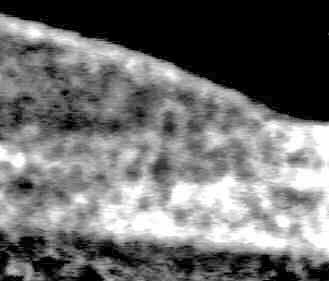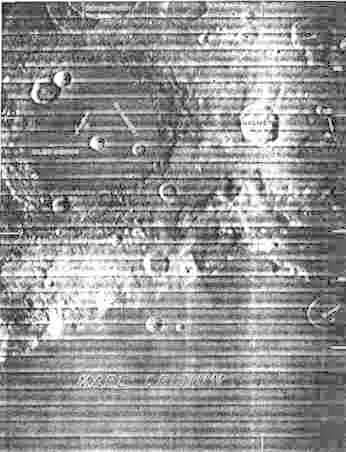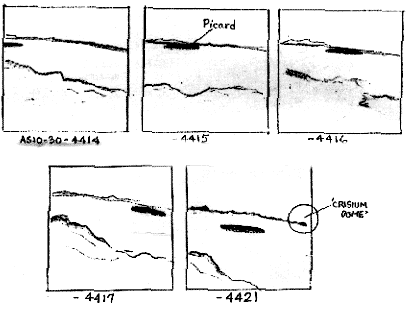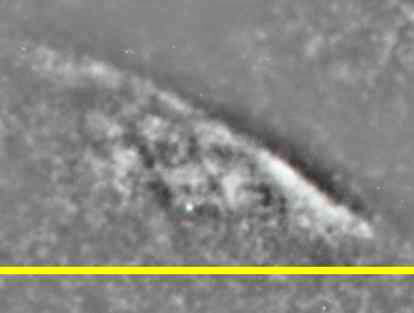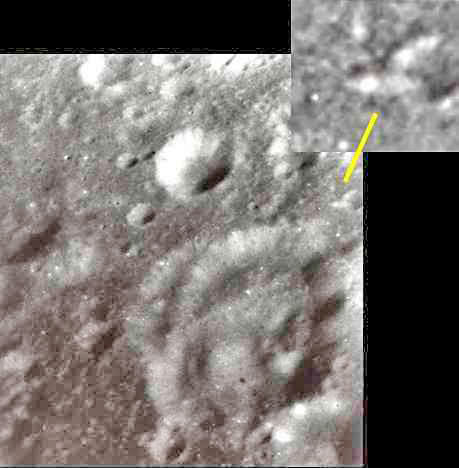|
by Steve Troy from LunarAnomalies Website
Glass Dome(s) in Mare
Crisium?
Steve has been quietly working to confirm
Hoaglandís artificial Lunar anomalies hypothesis for almost 2 years.
Steveís approach is entirely analog, sifting through the reams of
data and catalogs provided by a variety of NASA archives. He
is finding numerous anomalies and discrepancies in his studies, both
with regard to the unnatural "geology" and the also with the
photoís themselves. I was asked to provide image enhancement and
confirmation of Steveís findings using standard digital techniques.
Fleming has focused primarily on the
craters Pierce and Picard in Mare Crisium, and
more specifically on a set of "arches" apparently over Picard on
this image. While Steve and I have noted the "arches" and plan to
work on them later, we are focused on another part of 4421. Assuming
others may be examining this frame, we have decided to post our
preliminary results so that the other researchers may cross confirm
our findings as well. Richard Hoagland concurs with this
decision.
AS10-30-4421 From 5 X
7 Sectional
This is an unenhanced scan of Steveís
original analog photo of AS10-30-4421. He first noticed the
very bright area in the right center of the image. A quick
examination of the 8 X 10 print showed that this area has the
highest albedo in the entire photograph.
One of the key frames I have examined
is AS10-30-4421. This photograph is a view across the plain
of Mare Crisium emphasizing the crater Picard and the
North shore of the basin. This high-Sun oblique photograph is
centered at 55 degrees east longitude, 14 degrees north latitude.
It is also brighter than any other natural or anomalous formation in the series 4414-4420. With an 8X lupe and a light table one can see - upon examining sectionals of this area - a transparent, Dome-like shape that apparently is along the north Maria edge.
Its transparency is confirmed by tracing the mountains behind the object, which are visible through this immense dome like shape. I obtained other views of this area and am currently looking at the whole Apollo Crisium "Series" with Mike Bara.
NSSDC has been most cooperative in responding to this as well as all photo neg requests.
AS10-30-4421 image map. Picard is the crater just to the lower centerof the frame.
Cleomedes F and
Cleomedes Fa are just to the right of the image edge. 4421 in is an oblique image taken at high sun from an altitude of 60km.
On vertical shots from Lunar Orbiter 4 (191H3 and north Crisium close up, 51-H3) this bright "Dome" canít be seen.(2) The Apollo 10 footprint maps show the angle of the photo. Comparative angles overlaid on the Lunar Orbiter photos as well as some Apollo 17 shots of the area show no such anomaly. It is my belief that the dome must be seen at the right sun angle due to its transparency and possible crystalline composition.
On the Lunar Orbiter 4 photos one can see a small bright ray crater that it is situated just inside the right 4421 footprint map photo boundary. The dome seen on 4421 could not be this crater reflection because it is higher than the mountains that tower over this region separating the northern Crisium highlands & the maria.
The mountains "Rise abruptly 3
kilometers above the flat maria area ".(3)
Scale must therefore be considered when looking at this feature
which is estimated to rise 3 to 4 miles vertically and 10-15 miles
horizontally from the maria floor area.
The first thing I noticed about Steveís analog five by seven sectional was the translucency of the dome.
I concur with his conclusion that the mountains can be seen through the dome. I also note that it has 2 distinct "corners" or edges, rather than blending in with the mountains behind.
This is highly unusual, as it seems to stand apart from the mountain chain. In addition, I noted a bright spot on the hillside just above and to the left of the main dome. Immediately to the right of this bright object is a faint cross-like object jutting from the hillside, and an odd spire or antenna seeming to rise from the left slope of the main dome. I also believe there is a second dome just beyond the right edge of the main dome.
Itís contour is visible through the body of the main dome. It is more opaque from the perspective of 4421 than is the main dome, and the area where it overlaps the main dome is the area of brightest albedo. This would be explained by the light sources of the two domes adding their brightness as they reflected the sunlight into the camera.
I believe there is a possibility that the image map is in error and that the twin domes are in fact covering the craters Cleomedes F and Cleomedes Fa. If this is correct, then the craters are in fact not "craters" at all.
Curiously, the entire image seems to be
oddly blurred, as if there were some fuzzy "Stuff" between
the camera and the north shore of Mare Crisium. Upon viewing these
characteristics of 4421 on my light board I immediately began
a series of image enhancements.
I was quite frankly stunned by what these revealed.
Under enhancement, the less distinct left edge of the Main Dome became more clearly defined, and this helps to determine itís location in front of the mountain chain along the North shore.
The now familiar translucent material is also seen to be intervening between the camera and the domes, accounting for much of the fuzzy quality and odd mottling apparent on the frame.
Some have asserted that this pattern is
an artifact of the JPEG compression process, however, the original
data was from TIFF images which do not suffer from this "tile"
effect. This intervening material is also consistent with Richard
Hoaglandís assertion of a box like "dome" over the entire Crisium
region (Martian Horizons - The Journal of the Mars
Mission, Vol2, No.5, Frame AS16-121-19438). The Dome also
appears to have a cellular structure identical to the "Castle",
and the "Tower" seen in the famous Hoagland data.
The Face
It has bilateral symmetry, a defined "Nose" "Mouth" and "Eye-Sockets", and a proximity to other highly anomalous objects. It is also isolated in the sense that there are no other obvious "Faces" along the length of the North Shore visible in this image.
This strongly suggests that it is a genuine feature rather than a collection of random bright and dark spots in the image. The "Face" is also situated on the hillside overlooking the "Dome", in such a way as to look down directly into the center of the main "Dome".
Richard Hoagland has strongly
cautioned me about the tendency to see faces everywhere, but it is
important to understand that I am not suggesting that this object
resembles a face, but rather I am comparing it more precisely to the
Face on Mars at Cydonia. Given the "headdress" and
other features I believe it compares favorably to the Cydonian
structure.
Using this system, I propose that this "Crisium
Face" is a Type II. We will pursue other images in an attempt to
verify details.
I have no idea what this object might represent but it stands out dramatically from the drab mountain chain it rests on and bears no resemblance to any explainable Lunar geology. It reflectivity suggests a metallic or crystalline construction.
This is reinforced by the fact that such a rounded surface would not reflect this much light if were made of typical "highland" material.
Note that it is nearly as bright as the
"Dome" in front of it, which we have already established is made
from a translucent glass like material.
This appears to be an antenna of watch tower of some kind, and itís middle portion is definitely obscured by the glass like material of the "Dome" itself. Note how the upper tip of the "Bowling Pin" is encased in the same glass like material and blots out the upper rim of the "Dome" behind it.
Again, a spike like object such as this
has no place in standard Lunar geology, and I am at a complete loss
to explain it as anything but artificial.
Again note the geometric "haze" above the horizon and the cellular structure of the 2 overlapping domes.
Conclusions
There is no reason to suspect that photographic defects or imaging artifacts account for their presence. The "Face" "Phoenix" and "Bowling Pin" are all genuine anomalies, not readily explainable by any natural process.
Their
proximity to each other is only further reinforcement of their
artificiality. I must therefore conclude that they are all likely
constructs.
Preface
After
thorough analog examination, it was sent to along with sectionals to
Richard Hoagland, and in í97 to Mike Bara for computer enhancement
confirmation on this, and now other data we are working on.
Consider Apollo 16:
The 4421 Dome could be a "flash-unit". It is far brighter than any
landform seen on any photo in the 4414-4420 series.
To play
the Devilís advocate here however as I did, if one draws a line from
a common landform or crater on the terrain of the West shore seen
both on 10-4421 and 11-6223 up passing Picard to the right of the
dome area on 4421 and to the bright crater area on 6223, both lines
on these photos do seem to meet a point on the North shore near each
other. I am not convinced however, that the bright crater and the
dome are one and the same.
Figure 1. If one looks at the AS10 footprint maps [2] one can coordinate the angle of 4421 with the 4421 photo.
If the map angle lines are
correct (and the may not be, which Iím about to get into) the Dome
location according to itís Selenographic location should be to the
left of Cleomedes F and Fa, two small Mare craters off the North
shore. The bright crater is located here. However, the Dome is
obviously seen as a much larger object that is transparent.
The 11-6223 photo enlargements and the LO-IV-54-H photo show the bright crater has merely splashed near shore. So size is a critical factor here. If the Dome is a "flash-unit", it would also not be visible under all conditions as this "bright crater" seems to be.
This small bright ray-crater is visible on almost any picture of Crisium taken from any distance - even trans-Earth Coast photographs.
Figure 2. In looking at the AS10 maps there are discrepancies.
The photo
angles for the series AS10-4414-4417 contradict what is shown on the
actual photos. Map angles drawn for this series show Picard along
the left angle line border which is consistent for only one of the
photographs - 4414. Picard changed position as the spacecraft
orbited and by the time 4416 was taken, it was in the middle of the
frame. If these discrepancies exist it is reasonable to deduce that
perhaps the 4421 photomap angle may not be accurate.
There is an astonishing, unmistakable and undeniable architecture or archeology that I have named "Malibu", for it reminds me of and clearly resembles California homes built into the sides of hills but on a much larger scale.
Figure 3. "Malibu". Yellow line indicates intersection of Mare plane
and highlands. There are angular supports conforming to the physical relief of the mountain slope.
Within, are vertical trusses and horizontal beams between them. It is sunlit and like the "bright crater", faces south-southeast overlooking the Mare. After finding this remarkable object, I returned to the AS10-4414-17 series as well as the foreground shore areas of AS11-6223 to search for similar structures. I discovered many smaller, rectilinear, concentric complexes peppered throughout the inland edges of this Pre-Imbrian basin.
On 11-6223 they are very clear and the orthogonal nature of them can be seen with a magnifying glass on sectionals. They have structural integrity and do not seem to fit within the traditional geology of mere "hummocky-treebarklike" patterns. I consulted geologic maps. [3]
In the traditional stratigraphic model one does see relatively degraded areas with mass wasting that has removed material from and within higher areas that are now depressions. There is a coarse patchy appearance in the steeper slopes along with crater modification. The geometric complexes in these areas just do not seem to fit within this model. (Fig 4).
They cover inland areas in the lower parts of frames 10-4414-17 and 11-6223 & seen more clearly on 6223.
Figure 4. AS11-42-6223. Two important observations take them out of the traditional model.
One is the fact that all of them, apart from the regular geometry,
are located on surfaces out of the path of further deposition and
wasting. The other is that the walls and height of these structures
appear higher than the natural terrain. For example, many are seen
along and near the rims of smaller 3-8 km craters and on plateaus
and relatively level areas.
If these were natural one would expect to see such structures on a scale of these things all around the craters where they appear and not such obvious locations and immense complex form as these have. These to me all suggest artificiality and not random manipulations of natural lunar geology. The central area of Lick crater also reveals some similar shapes.
Other frames from
different mission of this area are currently being examined. Stay
tuned.
|


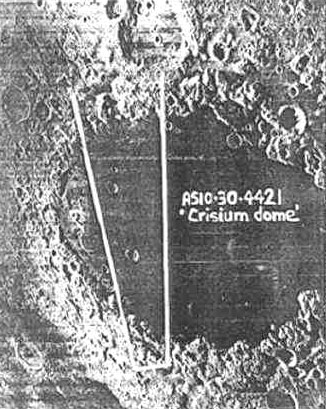
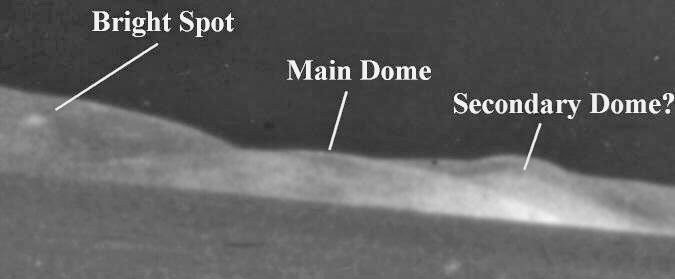
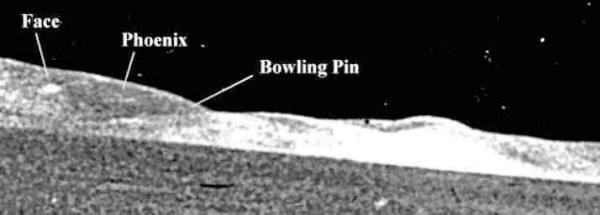
 object,
displays all the necessary characteristics to be included as a
potential monument.
object,
displays all the necessary characteristics to be included as a
potential monument.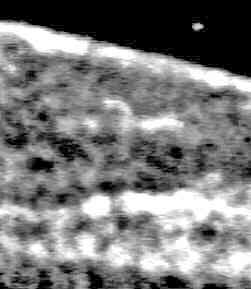 The
Phoenix
The
Phoenix